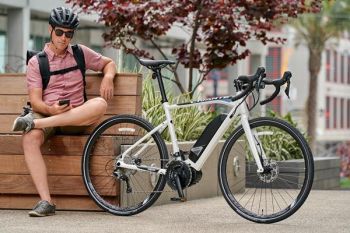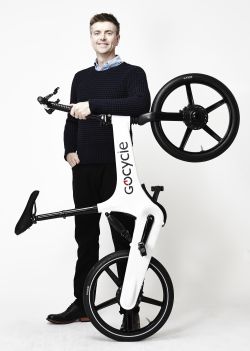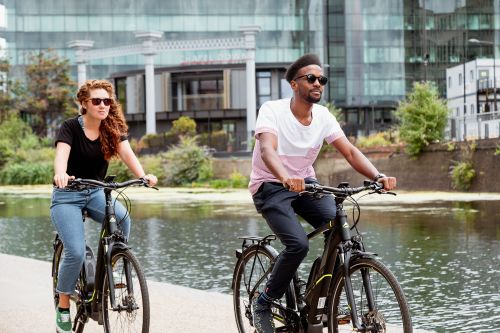Editor's note: A version of this article ran in the July issue of BRAIN. This version has been updated with new quotes from Bosch and Aventon and the latest sales figures.
SANTA CRUZ, Calif. (BRAIN) — As the industry debates whether the pandemic-driven bike boom will end with a bust as supply dwindles, or reset as the new normal for years, consider one key difference between this boom and the early 1970s edition: This time we have e-bikes.
"We have a new asset at hand, which is the e-bike," said Ewoud van Leeuwen, the general manager of Gazelle North America.
E-bike sales boomed along with the rest of the bike categories since the pandemic lockdowns began in the U.S. in mid-March.
"For Gazelle, by the middle or end of March we came to a bit of a stop, but by the second week of April things started to get going again and then since then it hasn't stopped, it's only increased," van Leeuwen said.
Most analysts predicted e-bike sales would continue to grow in 2020, and they have exceeded those predictions. But what excites them more now is the potential for after the pandemic.
Electric bike sales were up 84% in March, 92% in April, and 137% in May, the latest NPD numbers available.
"Eventually the markets are going to open up and people will look at bikes as an alternative mode of transportation over public transportation or even (personal) cars or rideshare," van Leeuwen said. "As an industry, we are really well-positioned, and hopefully, people will realize that e-bikes are a quick alternative. They make the bike market much more accessible for everyone."
Compound growth
Some retailers said e-bikes were the last to go, after they ran out of more affordable bikes. But all e-bike vendors, whether they sell through bike shops or online, reported that spring sales greatly exceeded forecasts, and those forecasts were ambitious to start with.
 "E-bike growth has continued at historic levels," said Dirk Sorenson, a sports industry analyst at The NPD Group. Electric bike sales were up 84% in March, 92% in April, and 137% in May, the latest NPD numbers available.
"E-bike growth has continued at historic levels," said Dirk Sorenson, a sports industry analyst at The NPD Group. Electric bike sales were up 84% in March, 92% in April, and 137% in May, the latest NPD numbers available.
Claudia Wasko, the vice president and general manager of Bosch eBike Systems for the Americas, said some of Bosch's OE customers in the U.S. were setting sales records in May and she expected the trend to continue.
"We believe a lot of this momentum will remain: e-bikes provide an ideal solution for individual transportation, especially during the corona crisis but also in the post-corona era," she told BRAIN.
Aventon Bikes saw e-bike demand up 600% in June, said the brand's chief marketing officer, Adele Nasr. "We have been busier than ever before," Nadr said. "We are literally breaking records daily on orders and sales."
In June, Aventon's sales were up over 1,000% in Maryland, Michigan and Virginia, and over 600% in Texas, the company said.
Rad Power Bikes, which is among the largest B2C e-bike brands in the U.S. market, said demand was up nearly 300% in mid-May. Even as the Seattle company was adapting to COVID-19 work restrictions, it doubled the size of its customer experience and product support teams to meet the demand.
Consumers research a single e-bike purchase more carefully than they do a family's worth of neighborhood cruisers. Luckily, they've had plenty of time to research, said Richard Thorpe, the CEO of UK-based GoCycle.
The company, which makes upscale folding e-bikes, has seen web searches for its brand increase more than 100% this year, he told BRAIN.
"The pandemic has basically pulled the adoption curve forward for e-bikes" — Richard Thorpe, GoCycle CEO.
"(The lockdown) was an opportunity to get information to people who had time to go online. For us — and for other brands, but for us in particular — it has been quite good because people have gone online and when they search for the best electric folding bikes we come up with fantastic reviews," he said.
"COVID has basically pulled the adoption curve forward for e-bikes," he said. In the U.Se-bikes were in the "early adopter" phase before the pandemic, he reckoned. Now they are in the "early majority" phase."
'The only credible solution'
Thorpe said that for most consumers seriously looking to avoid public transportation for their commute indefinitely, e-bikes are "the only credible solution."
"If you suddenly want to commute 5-10 miles to work each day, most people can't do that on a regular bike. That's 100 miles a week. But anyone can do that on an e-bike."
 Some commuters may adopt standard bikes this summer, but reconsider next winter, he predicted.
Some commuters may adopt standard bikes this summer, but reconsider next winter, he predicted.
"Most of those lower-end bikes are going to be put in the garage and won't be taken out next year. The people who invest in e-bikes will be the ones who continue bike commuting. They make it easier to get out the door, even on a cold, rainy day. They are the ones that are going to stick with it for the long term."
Rob Trester, the manager of Yamaha Motor's smart power vehicle division, has a similar theory about how e-bikes will extend the boom. Trester said Yamaha has seen strong sales this year of its e-bikes, but he's more excited about the interest in cycling in general, which he predicts will lead to more e-bike sales down the road.
"It's exciting to see a little rebirth of bicycling; I'm hoping we are building some bicyclists for life ... that will increase the interest in e-bikes even more. It's just a bigger pool of people who are coming back to the sport and who see bikes as an acceptable form of transportation."
It's not all transportation
Larry Pizzi, Alta Cycling Group's chief commercial officer, said he's seeing growth in all types of e-bikes, including ACG's high-end Haibike electric mountain bikes.
"We have a couple of things going for us: People are not anytime soon going to be getting on public transportation or Uber. The whole transportation thing is really good for us; it has huge legs for the next year or more.
"The recreational and fitness cycling component is a little more tenuous. I think a lot of that pool already bought bikes, so it's hard to predict where the real long term opportunity lies in that area. There are a lot of variables.
"But interestingly enough, lately Haibike sales have been off the hook. That's not a transportation product, that's pure recreation and there's not a model in that range that sells for less than $3,000. ... We're seeing a lot of cyclists coming around to eMTBs. The 45-65-year-old is the biggest demographic, but we're also seeing a lot of younger enthusiasts who want to add an electric mountain bike to their collection. That's the most exciting thing: the category has become mainstream."


